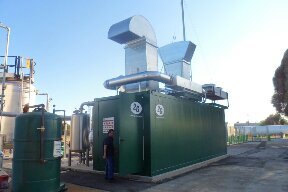CWP Opens Organic Waste-to-Energy Plant in Sacramento
The plant uses 2G Energy's advanced CHP system to produce electricity and heat from food waste and cardboard.
Facts & figures

A new facility has been established in Sacramento, California, by CWP. It is an organic waste-to-energy plant that utilizes proprietary high-solids anaerobic digester technology to convert separated organics into energy and soil amendments. The CHP system consists of a containerized 2G patruus 190 with an electrical load capacity of 190 kW/h or 1,577 MW/h per year. The thermal capacity is 235 kWh/th. The anaerobic digester has the capability of digesting material containing up to 50% solids. The biogas plant and CHP system are designed to process 7.5 tons of commercial and retail food waste daily, along with ½ tons of non-recyclable corrugated cardboard.
The plant owner selected 2G Energy Inc. because of its advanced and proven technology, coupled with custom design and short lead times. He also decided to install the 2G Thermal Heat Distribution System, including a Hydronic Junction. It assures that the CHP maintains optimum thermal performance at any time in different load situations. This advanced technology decouples the primary heating source circuit from the secondary consumer circuit, thereby achieving consistent function in all operating states. 2G THDAs provide the most energy-efficient heat transfer. The system also allows for tighter temperature control due to the infinite system's ability to regulate temperatures gradually. The controls and switchgear, including utility interconnection, are also supplied by 2G. In addition to the CHP unit, 2G Energy Inc. supplied the complete gas treatment, including cooler, dryer/dehumidification, and the H2S removal system. This advanced CHP system is equipped with BACT (Best Available Control Technology) for emissions control, coupled with an SCR (Selective Catalytic Reduction) technology package to achieve ultra-low emissions required in California.


